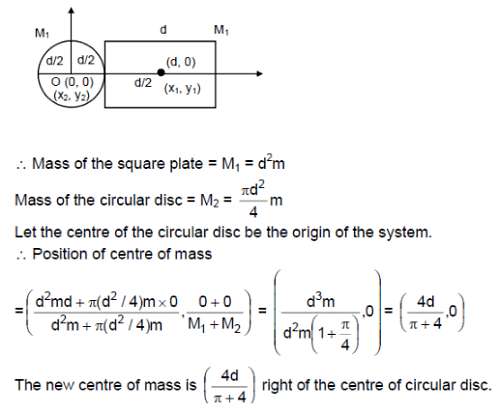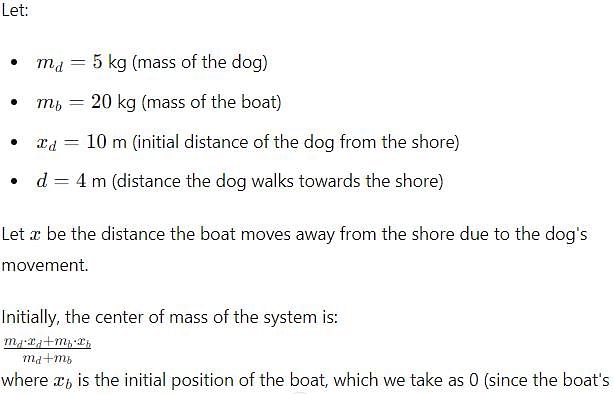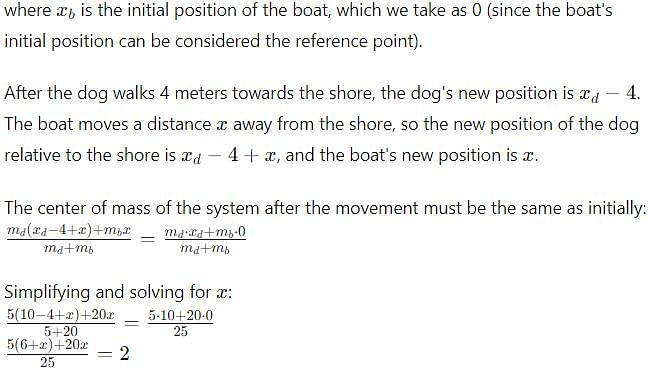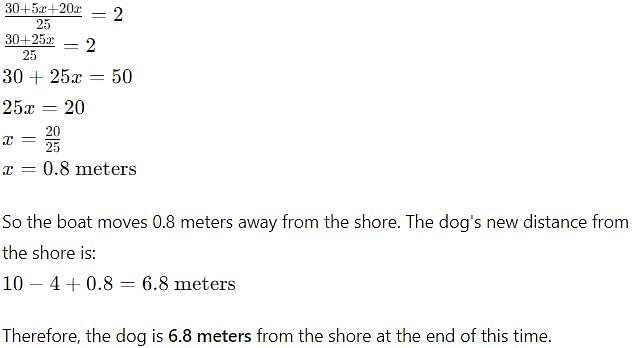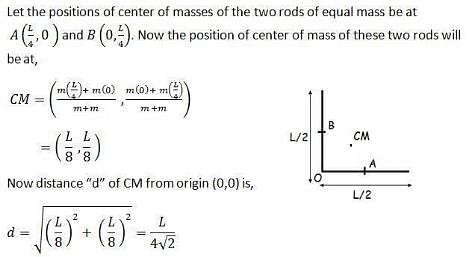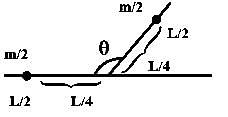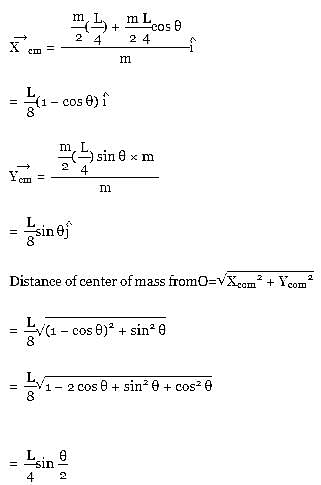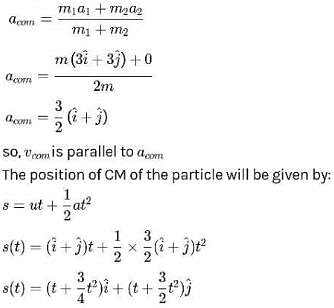Test: Centre Of Mass (Competition Level) - JEE MCQ
30 Questions MCQ Test Chapter-wise Tests for JEE Main & Advanced - Test: Centre Of Mass (Competition Level)
A square plate and a circular plate made up of same material are placed touching each other on a horizontal table. If the side length of square plate is equal to diameter of the circular plate, then the centre of mass of the combination will be
A rigid body consists of a 3 kg mass located at  and a 2 kg mass located at
and a 2 kg mass located at  .The position of center of mass is
.The position of center of mass is
| 1 Crore+ students have signed up on EduRev. Have you? Download the App |
A dog weighing 5 kg is standing on a flat boat so that it is 10 meters from the shore. It walks 4 m on the boat towards the shore and then halts. The boat weighs 20 kg and one can assume that there is no friction between it and water. The dog from the shore at the end of this time is
Particles of masses 1 kg and 3 kg are at m then instantaneous position of their centre of mass is
Two bodies of masses 5 kg and 3 kg are moving towards each other with 2 m/s and 4 m/s respectively. Then velocity of centre of mass is
A uniform metre rod is bent into L shape with the bent arms at 90o to each other. The distance of the centre of mass from the bent point is
A uniform straight rod is placed in vertical position on a smooth horizontal surface and released. As the rod is in motion, the centre of mass moves
A thin uniform rod of length L is bent at its mid point as shown in the figure. The distance of the centre of mass from the point O is
Four bodies of masses 1, 2, 3, 4 kg respectively are placed at the corners of a square of side ‘a’. Coordinates of centre of mass are (take 1 kg at the origin, 2 kg on x-axis and 4 kg on y-axis)
Two identical thin uniform rods of length L each are joined to form T shape as shown in the figure. The distance of centre of mass from D is
Figure shows a square plate of uniform thickness and side length √2 m. One fourth of the plate is removed as indicated. The distance of centre of mass of the remaining portion from the centre of the original square plate is
Two particles of equal masses have velocities First particle has an acceleration
while the acceleration of the other particle is zero. The centre of mass of the two particles moves in a path of
The centre of mass of a non uniform rod of length L whose mass per unit length where k is a constant and x is the distance from one end is
In the Fig. shown, pulley is tight, frictionless and string is inextensible. System is released at t = 0, at t = 2 sec
Two bodies of masses m1 and m2 are moving with velocity v1 and v2 respectively in the same direction. The total momentum of the system in the frame of reference attached the centre of mass is (v is relative velocity between the masses)
A body of mass m moving at a constant velocity v hits another body of the same mass moving with a velocity v/2 but in the opposite direction and sticks to it. The common velocity after collision is
A rubber ball is dropped from a height of 5 m on a planet where the acceleration due to gravity is not known. On bouncing, it rises to 1.8 m. The ball loses its velocity on bouncing by a factor of
A body of mass 5 kg is acted on by a net force F which varies with time t as shown in graph, then the net momentum in SI units gained by the body at the end of 10 seconds is
A force time graph for the motion of a body is as shown in figure. Change in linear momentum between 0 and 6 s is
A body is acted on by a force given by F = (10 + 2t) N. The impulse received by the body during the first four seconds is
An impulse is applied to a moving object with the force at an angle of 120o with the velocity vector. The angle between the impulse vector and the change in momentum vector is
A ball of mass 10 g hits a hard surface vertically with a speed of 5 m/s and rebounds with the same speed. The ball remains in contact with the surface for 0.01 s. The average force exerted by the surface on the ball is
The linear momentum of a particle varies with time t as p = a + bt + ct2. Which of the following statement is correct?
A bomb of mass 12 kg, initially at rest explodes into two pieces of masses 4 kg and 8 kg. The speed of the 8 kg mass is 6 m/s. The kinetic energy of the 4 kg mass is
A 1 kg ball moving at 12 m/s collides head-on with a 2 kg ball moving in the opposite direction at 24 m/s. If the coefficient of restitution is 2/3 then the final speeds of the two balls are respectively
Ball 1 collides with another identical ball 2 at rest as shown in figure. For what value of coefficient of restitution e, the velocity of second ball becomes two times that of 1 after collision
“A truck of mass 15 tons moving with one meter per second collides with the stationary truck of 10 tons and they start to move together.
In the above question, the energy lost in the collision is”
A particle of mass 1 g moving with a velocity m/s experiences a perfectly inelastic collision with another particle of mass 2 g and moving with velocity
m/s. The velocity of the combined particle is
A batsman deflects a ball at an angle 90o without changing its initial speed which is equal to 54 km/h. The impulse imparted to the ball whose mass is 0.5 kg is
A ball moving with a constant speed hits another identical ball at rest. If co-efficient of restitution equals (2/3) then the ratio of speeds of the second ball to that of the first ball after collision will be
|
447 docs|930 tests
|
|
447 docs|930 tests
|


